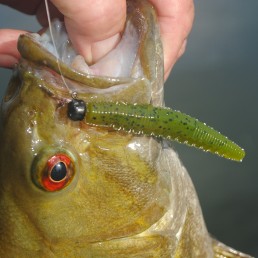In the Good Old Summertime
SHARE THIS POST
Summer is sometimes considered a time when the fish don’t want to bite a bait. While there is an abundance of food in the water for fish to eat, and weather systems can put the fish in a bit of a funk, the summer months can provide outstanding fishing. Much of that outstanding fishing will take place in rivers. Wherever you live, there is probably a river close by, and the fish in that river are willing to eat, even during hot weather. River fish are constantly dealing with current. They need to eat more often to maintain their energy levels. In the summer months, rivers can provide consistent fishing action.
River fish like to be near something that breaks the current. It could be a rock, log, or a bridge piling. When they’re resting, they’ll be on the downstream side of the object, out of the current. When they’re hungry, they’ll usually move to the edge of the current, waiting to ambush a minnow or something else that they might like to eat. Always remember that river fish like to be around fixed objects in rivers.
Many baits will catch river fish, but if you’re after bass, walleyes or pike, it’s hard to beat a jig tipped with plastic. A 1/8-ounce jig tipped with a smaller Rage Swimmers or a Rage Grub can be outstanding. The action tail on the Grub will attract fish better in stained water, and Swimmers are often more appealing to walleyes and smallmouths.
Small crankbaits like a Series 3 Strike King Pro Model can be very productive. You’ll usually do best with a bait that runs down to about 5 feet unless you’re trolling open water. A bait with some brown, orange, or red is a good starting point. Crawdads are an important food source in many rivers, and brown, red, and orange baits resemble crawdads. Keep trying different colors until the fish reveal if there’s a particular color that they want. Much of the time, river fish don’t care about color.
Lure presentation is important. Hungry river fish are usually facing upstream. Fish instinctively know that most of their food moves downstream with the current, so a fish that wants to eat will face upstream so it can better see a minnow or bug or whatever coming toward it. Usually, it works well to cast cross-stream and retrieve the bait, so it washes into suspected fish-holding areas.
Are you enjoying this post?
You can be among the first to get the latest info on where to go, what to use and how to use it!
Smaller rivers are best fished by wading. If you like to get in the water, it is often most productive to start downstream and work upstream. By doing so, you will be presenting your bait in a downstream manner, and you’ll be less likely to alert the fish to your presence.
Also, if you’re wading, keep quiet and move slowly. Don’t get in the water if you don’t need to. Try Keep a low profile. If you’re on top of the riverbank, fish can easily see you and may spook. As much as possible, stay at river level.
Rivers everywhere provide outstanding fishing experiences throughout the hottest time of the year. Find a river near where you live and get on it or in it. If you do that once, you’ll do it again.
You’ll find plenty of helpful summer fishing tips in the summer issues of MidWest Outdoors. Subscribe on our website.
MWO
SHARE THIS POST
You may also like...
Nothing found.
Did you enjoy this post?
You can be among the first to get the latest info on where to go, what to use and how to use it!
Bob Jensen
To see the latest episodes of “Fishing the Midwest” television, new fishing-related tips and articles from the past, visit fishingthemidwest.com. Follow them on Facebook @fishingthemidwest for fishing information and entertainment.
